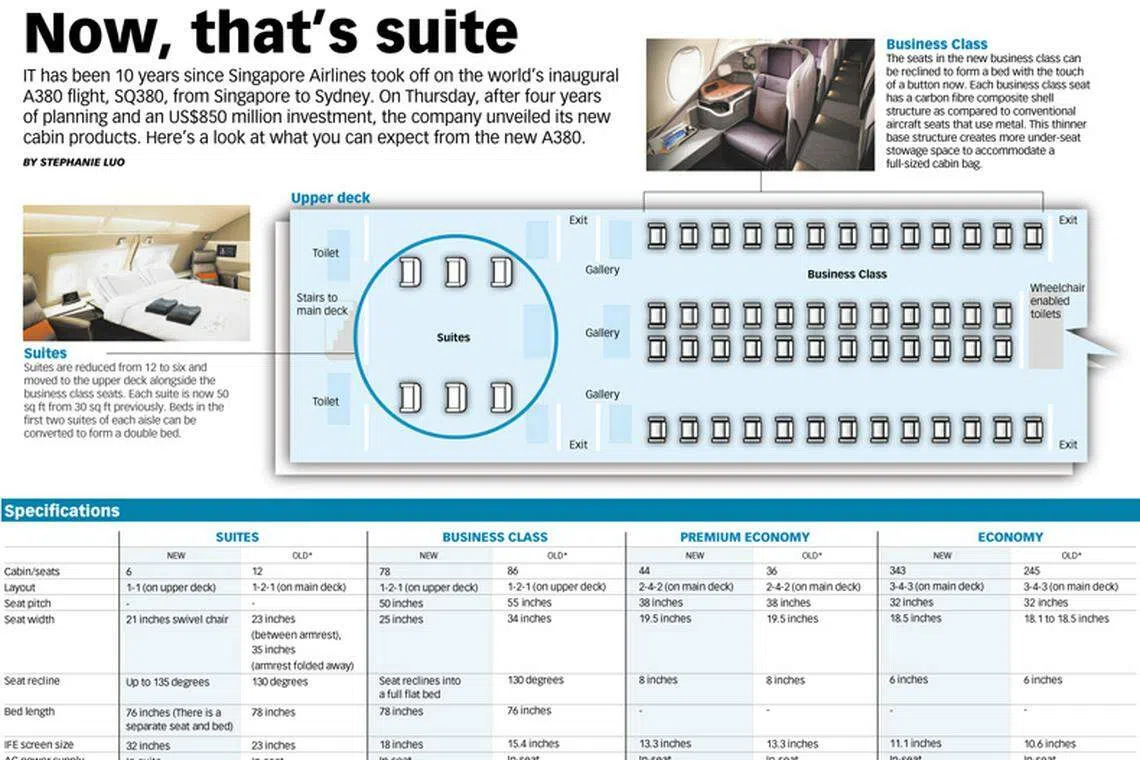SIA takes on rivals with US$850m bet on A380 cabin makeover

Nisha Ramchandani
Singapore
TEN years after it took delivery of its first A380 jumbo jet back in 2007, Singapore Airlines (SIA) has unveiled its first major cabin facelift for the plane, which will see it channelling US$850 million towards 19 aircraft.
The hefty sum that the airline is splashing out is an indication of just how cut-throat the competition is today. Rivals such as the Gulf trio and Cathay Pacific are prompting Singapore's flag carrier to up the ante while a tough operating environment continues to put pressure on yields.
Life cycles for cabin products are also getting shorter in tandem with rising passenger expectations, with SIA having introduced its last cabin refresh for the 777 in 2013.
Four years in the making, the eagerly-anticipated product launch has generated a fair amount of buzz in the months leading up to the event which took place on Thursday morning at Suntec Convention Centre. And while the latest refresh takes place across all cabins, the most significant changes are at the premium end of the plane, where SIA receives a sizeable chunk of revenue.
"On the same route (as other airlines), I'm sure this product will make us more competitive and and more desired by our customers," said SIA chief Goh Choon Phong, speaking to media at the sidelines of the launch event. "That will give us a competitive edge."
From Dec 18, the new A380 will be deployed to Sydney - the same destination for SIA's first A380 in 2007. The refreshed cabins will be available across the entire A380 fleet by 2020. Five of SIA's 19 jumbo jets will be new aircraft; the rest will be retrofitted.

The airline's most luxurious offering, the Suites, will be halved from twelve units to six, but SIA is dialling up the comfort by boosting each Suite from 30 to 50 sq ft. With sliding doors for privacy, a separate bed alongside a leather-upholstered seat which swivels as well as a 32-inch HD touch screen, the cabin is akin to a plush hotel room in the sky.
Over in Business Class, a carbon fibre composite shell for the seat creates a thinner base structure for better use of space and delivers more under-seat stowage space. The 78-inch-long fully flat bed is now two inches longer but seat pitch and seat width will come down from 55 inches to 50 inches, and 34 inches to 25 inches respectively.
While the new A380s won't reproduce some of the swankier offerings rolled out by other carriers such as an onboard lounge or shower, the use of onboard real estate is in line with what SIA's passengers want, the airline's management highlighted.
But as SIA grapples with intensifying competition from the Chinese and Middle Eastern carriers, analysts are split on what the new A380s might mean for revenue and yields.
"Overall, there should be an improvement in SIA's A380 operations," reckons Centre for Aviation (CAPA) analyst Brendan Sobie, adding that the enhanced products could achieve higher yields and load factors for the premium cabins. Meanwhile, in the economy and premium economy cabins, the increased seat density could translate to higher revenue even if yields continue to remain depressed, Mr Sobie pointed out.
Reconfiguring the aircraft, such as shifting the Suites from the lower deck to upper deck as well as tweaking the number of seats, has helped SIA to bump up the number of premium economy and economy seats.
As a result, the total number of seats across the four cabins on the new A380 will now go up to 471; currently, it has two configurations of A380s flying with 441 and 379 seats respectively.
The challenge might well be filling all those seats, given the premium that SIA charges and the fact that corporates are tightening their purse strings, said Endau Analytics aviation analyst Shukor Yusof. "My scepticism is that they are pushing aggressively on the premium segment. That side of the market has deteriorated quite a bit," said Mr Yusof.
Some airlines have cut the number of first-class seats in their cabins, or done away with first class on international routes.
"SIA is trying to bolster demand for its products and services in the wake of increased competition," said another analyst, who declined to be named. "It remains to be seen to what extent this would bolster yields but it could abate the decline in yields."
The revamp will also help keep SIA's A380 fleet flying for the eight to ten years ahead at a point where second-hand demand for the model may be soft, Mr Sobie suggested.
As SIA invests in new planes such as the 777-9s and overhauls its cabins, the competition is doing the same. Qatar Airways released a souped up business class earlier this year known as the QSuite, while Emirates is expected to reveal a new first-class cabin for its Boeing 777-300ER aircraft at the Dubai Airshow this month. Etihad's three-room The Residence comes with butler service and a living room. A new regional business class seat is also in the works for SIA's upcoming B787-10s.
Still, in aviation's dynamic operating environment, to stand still is to go backwards.
The SIA group, which recently embarked on a transformation programme to better position itself for the future, is striving to maintain its edge. Delivering better offerings for passengers will be a key part of its strategy to fend off the competition.
READ MORE: BT Infographics: SIA's new cabin products
Copyright SPH Media. All rights reserved.
